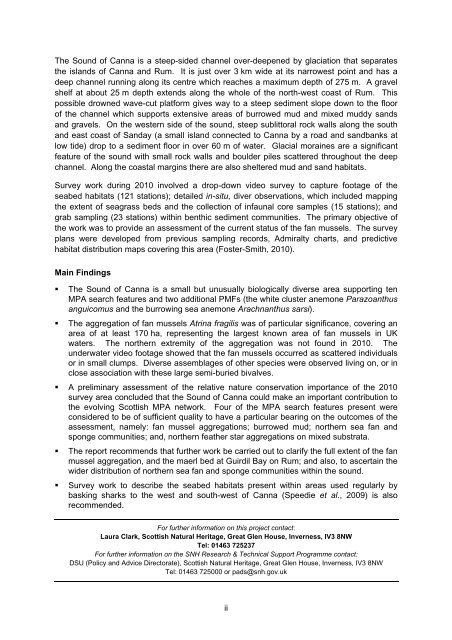Marine biological survey to establish the distribution and status of ...
Marine biological survey to establish the distribution and status of ...
Marine biological survey to establish the distribution and status of ...
Create successful ePaper yourself
Turn your PDF publications into a flip-book with our unique Google optimized e-Paper software.
The Sound <strong>of</strong> Canna is a steep-sided channel over-deepened by glaciation that separates<br />
<strong>the</strong> isl<strong>and</strong>s <strong>of</strong> Canna <strong>and</strong> Rum. It is just over 3 km wide at its narrowest point <strong>and</strong> has a<br />
deep channel running along its centre which reaches a maximum depth <strong>of</strong> 275 m. A gravel<br />
shelf at about 25 m depth extends along <strong>the</strong> whole <strong>of</strong> <strong>the</strong> north-west coast <strong>of</strong> Rum. This<br />
possible drowned wave-cut platform gives way <strong>to</strong> a steep sediment slope down <strong>to</strong> <strong>the</strong> floor<br />
<strong>of</strong> <strong>the</strong> channel which supports extensive areas <strong>of</strong> burrowed mud <strong>and</strong> mixed muddy s<strong>and</strong>s<br />
<strong>and</strong> gravels. On <strong>the</strong> western side <strong>of</strong> <strong>the</strong> sound, steep sublit<strong>to</strong>ral rock walls along <strong>the</strong> south<br />
<strong>and</strong> east coast <strong>of</strong> S<strong>and</strong>ay (a small isl<strong>and</strong> connected <strong>to</strong> Canna by a road <strong>and</strong> s<strong>and</strong>banks at<br />
low tide) drop <strong>to</strong> a sediment floor in over 60 m <strong>of</strong> water. Glacial moraines are a significant<br />
feature <strong>of</strong> <strong>the</strong> sound with small rock walls <strong>and</strong> boulder piles scattered throughout <strong>the</strong> deep<br />
channel. Along <strong>the</strong> coastal margins <strong>the</strong>re are also sheltered mud <strong>and</strong> s<strong>and</strong> habitats.<br />
Survey work during 2010 involved a drop-down video <strong>survey</strong> <strong>to</strong> capture footage <strong>of</strong> <strong>the</strong><br />
seabed habitats (121 stations); detailed in-situ, diver observations, which included mapping<br />
<strong>the</strong> extent <strong>of</strong> seagrass beds <strong>and</strong> <strong>the</strong> collection <strong>of</strong> infaunal core samples (15 stations); <strong>and</strong><br />
grab sampling (23 stations) within benthic sediment communities. The primary objective <strong>of</strong><br />
<strong>the</strong> work was <strong>to</strong> provide an assessment <strong>of</strong> <strong>the</strong> current <strong>status</strong> <strong>of</strong> <strong>the</strong> fan mussels. The <strong>survey</strong><br />
plans were developed from previous sampling records, Admiralty charts, <strong>and</strong> predictive<br />
habitat <strong>distribution</strong> maps covering this area (Foster-Smith, 2010).<br />
Main Findings<br />
• The Sound <strong>of</strong> Canna is a small but unusually <strong>biological</strong>ly diverse area supporting ten<br />
MPA search features <strong>and</strong> two additional PMFs (<strong>the</strong> white cluster anemone Parazoanthus<br />
anguicomus <strong>and</strong> <strong>the</strong> burrowing sea anemone Arachnanthus sarsi).<br />
• The aggregation <strong>of</strong> fan mussels Atrina fragilis was <strong>of</strong> particular significance, covering an<br />
area <strong>of</strong> at least 170 ha, representing <strong>the</strong> largest known area <strong>of</strong> fan mussels in UK<br />
waters. The nor<strong>the</strong>rn extremity <strong>of</strong> <strong>the</strong> aggregation was not found in 2010. The<br />
underwater video footage showed that <strong>the</strong> fan mussels occurred as scattered individuals<br />
or in small clumps. Diverse assemblages <strong>of</strong> o<strong>the</strong>r species were observed living on, or in<br />
close association with <strong>the</strong>se large semi-buried bivalves.<br />
• A preliminary assessment <strong>of</strong> <strong>the</strong> relative nature conservation importance <strong>of</strong> <strong>the</strong> 2010<br />
<strong>survey</strong> area concluded that <strong>the</strong> Sound <strong>of</strong> Canna could make an important contribution <strong>to</strong><br />
<strong>the</strong> evolving Scottish MPA network. Four <strong>of</strong> <strong>the</strong> MPA search features present were<br />
considered <strong>to</strong> be <strong>of</strong> sufficient quality <strong>to</strong> have a particular bearing on <strong>the</strong> outcomes <strong>of</strong> <strong>the</strong><br />
assessment, namely: fan mussel aggregations; burrowed mud; nor<strong>the</strong>rn sea fan <strong>and</strong><br />
sponge communities; <strong>and</strong>, nor<strong>the</strong>rn fea<strong>the</strong>r star aggregations on mixed substrata.<br />
• The report recommends that fur<strong>the</strong>r work be carried out <strong>to</strong> clarify <strong>the</strong> full extent <strong>of</strong> <strong>the</strong> fan<br />
mussel aggregation, <strong>and</strong> <strong>the</strong> maerl bed at Guirdil Bay on Rum; <strong>and</strong> also, <strong>to</strong> ascertain <strong>the</strong><br />
wider <strong>distribution</strong> <strong>of</strong> nor<strong>the</strong>rn sea fan <strong>and</strong> sponge communities within <strong>the</strong> sound.<br />
• Survey work <strong>to</strong> describe <strong>the</strong> seabed habitats present within areas used regularly by<br />
basking sharks <strong>to</strong> <strong>the</strong> west <strong>and</strong> south-west <strong>of</strong> Canna (Speedie et al., 2009) is also<br />
recommended.<br />
For fur<strong>the</strong>r information on this project contact:<br />
Laura Clark, Scottish Natural Heritage, Great Glen House, Inverness, IV3 8NW<br />
Tel: 01463 725237<br />
For fur<strong>the</strong>r information on <strong>the</strong> SNH Research & Technical Support Programme contact:<br />
DSU (Policy <strong>and</strong> Advice Direc<strong>to</strong>rate), Scottish Natural Heritage, Great Glen House, Inverness, IV3 8NW<br />
Tel: 01463 725000 or pads@snh.gov.uk<br />
ii

















